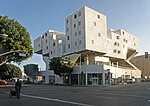Cast Iron Commercial Building
Buildings and structures in Los AngelesCalifornia stubsLos Angeles Historic-Cultural Monuments

The Cast Iron Commercial Building is an historic building in Los Angeles, California, United States. Built in 1903, the brick structure exhibits Queen Anne architecture with Italianate details. The Cast Iron Commercial Building has been designated a Los Angeles Historic-Cultural Monument.
Excerpt from the Wikipedia article Cast Iron Commercial Building (License: CC BY-SA 3.0, Authors, Images).Cast Iron Commercial Building
San Pedro Street, Los Angeles Downtown
Geographical coordinates (GPS) Address Nearby Places Show on map
Geographical coordinates (GPS)
| Latitude | Longitude |
|---|---|
| N 34.039583333333 ° | E -118.24763888889 ° |
Address
San Pedro Street
San Pedro Street
90014 Los Angeles, Downtown
California, United States
Open on Google Maps







